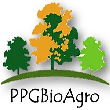Banca de DEFESA: UBIRANEI DE FREITAS MARINHO
Uma banca de DEFESA de MESTRADO foi cadastrada pelo programa.DISCENTE : UBIRANEI DE FREITAS MARINHO
DATA : 30/08/2023
HORA: 13:30
LOCAL: Sala de vídeo conferência
TÍTULO:
Use of biofertilizer in phosphate nutrition of soybean and corn in an amazon agroecosystemPALAVRAS-CHAVES:
Phosphate-solubilizing microorganisms, phosphorus availability, soil fertility, sustainable agriculture.
PÁGINAS: 73
GRANDE ÁREA: Ciências Agrárias
ÁREA: Agronomia
SUBÁREA: Ciência do Solo
ESPECIALIDADE: Fertilidade do Solo e Adubação
RESUMO:
The use of phosphate-solubilizing micro-organisms can enhance the efficiency of phosphate fertilizers and increase the availability of this nutrient to crops, particularly when associated with low-solubility fertilizers. In this study, our aim was to assess the effects of phosphate fertilization combined with the inoculation of phosphate-solubilizing micro-organisms on soybean and maize growth, soil and plant phosphorus content, biomass production, and phosphorus accumulation. The evaluated P sources were triple superphosphate, Bayóvar phosphate, and calcined bone + poultry litter, all at a dose of 30 mg dm³ of total P, with and without seed inoculation using Bacillus subtilis (BRM 2084) and Bacillus megaterium (BRM 119). The experimental design was a randomized complete block with a 4 x 2 factorial scheme and four replications. Our results showed that inoculation with phosphate-solubilizing microorganisms increased phosphorus availability in the soil when combined with calcined bone + poultry litter and Bayóvar phosphate. The presence of the inoculant was significant in increasing leaf nitrogen levels, particularly when combined with calcined bone + poultry litter and Bayóvar phosphate. Bayóvar phosphate and calcined bone + poultry litter fertilizers demonstrated comparable efficacy to triple superphosphate in promoting plant growth, possibly due to the use of microorganisms that enhanced the efficiency of these fertilizers. The treatment with triple superphosphate in the presence of the inoculant showed the highest values for dry matter accumulation and soybean leaf phosphorus levels. Both triple superphosphate and calcined bone + poultry litter presented similar phosphorus levels in the aboveground and root parts of maize. In the presence of the inoculant, all phosphorus sources resulted in greater plant height compared to the control. Treatments with Bayóvar phosphate and calcined bone + poultry litter provided the highest plant height. The use of phosphate-solubilizing microorganisms potentially improved phosphorus utilization efficiency in calcined bone + poultry litter, resulting in greater P accumulation in the aboveground part of maize plants. The observed results of aboveground phosphorus accumulation in maize were influenced by the interaction between phosphorus sources and the presence of the inoculant. Our findings indicate that inoculation with phosphate-solubilizing microorganisms associated with different phosphate sources can enhance phosphorus availability in the soil and promote growth and development of crops. This approach holds the potential to contribute to ecologically-based sustainable agriculture, reducing the nutrient demand in agriculture and mitigating the environmental impacts of industrialization and chemical fertilizer application.
MEMBROS DA BANCA:
Interno - 006.844.991-77 - GUILHERME FERREIRA FERBONINK - NÃO INFORMADO
Interno - 210865003 - GUSTAVO CAIONE
Externo à Instituição - CLEITON GREDSON SABIN BENETT - UEG



